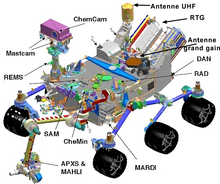The Final Frontier
Sharing What Hubble is all about
Saturday, April 11, 2020
Wednesday, January 20, 2016
Friday, March 6, 2015
Friday, March 15, 2013
Our Galaxy's "geysers" are towers of power
"Monster"
outflows of charged particles from the centre of our Galaxy, stretching
more than halfway across the sky, have been detected and mapped with
CSIRO's 64-m Parkes radio telescope.
- 3 January 2013
The outflows were detected by astronomers from Australia, the USA,
Italy and The Netherlands. They report their finding in today's issue
of Nature.
"These outflows contain an extraordinary amount of energy — about a million times the energy of an exploding star," said the research team's leader, CSIRO's Dr Ettore Carretti.
The speed of the outflow is supersonic, about 1000 kilometres a second. "That's fast, even for astronomers," Dr Carretti said.
"They are not coming in our direction, but go up and down from the Galactic Plane. We are 30,000 light-years away from the Galactic Centre, in the Plane. They are no danger to us."
From top to bottom the outflows extend 50,000 light-years (five hundred thousand million million kilometres) out of the Galactic Plane.
That's equal to half the diameter of our Galaxy (which is 100,000 light-years — a million million million kilometres — across).
Seen from Earth, the outflows stretch about two-thirds across the sky from horizon to horizon.
The outflows correspond to a "haze" of microwave emission previously spotted by the WMAP and Planck space telescopes and regions of gamma-ray emission detected with NASA's Fermi space telescope in 2010, which were dubbed the "Fermi Bubbles".
The WMAP, Planck and Fermi observations did not provide enough evidence to indicate definitively the source of the radiation they detected, but the new Parkes observations do.
To finish reading article CLICK HERE
"These outflows contain an extraordinary amount of energy — about a million times the energy of an exploding star," said the research team's leader, CSIRO's Dr Ettore Carretti.
"These outflows contain an extraordinary amount of energy — about a million times the energy of an exploding star."
But the outflows pose no danger to Earth or the Solar System.
Dr Ettore Carretti, CSIRO Astronomy and Space Science
The speed of the outflow is supersonic, about 1000 kilometres a second. "That's fast, even for astronomers," Dr Carretti said.
"They are not coming in our direction, but go up and down from the Galactic Plane. We are 30,000 light-years away from the Galactic Centre, in the Plane. They are no danger to us."
From top to bottom the outflows extend 50,000 light-years (five hundred thousand million million kilometres) out of the Galactic Plane.
That's equal to half the diameter of our Galaxy (which is 100,000 light-years — a million million million kilometres — across).
Seen from Earth, the outflows stretch about two-thirds across the sky from horizon to horizon.
The outflows correspond to a "haze" of microwave emission previously spotted by the WMAP and Planck space telescopes and regions of gamma-ray emission detected with NASA's Fermi space telescope in 2010, which were dubbed the "Fermi Bubbles".
The WMAP, Planck and Fermi observations did not provide enough evidence to indicate definitively the source of the radiation they detected, but the new Parkes observations do.
To finish reading article CLICK HERE
Friday, August 3, 2012
Saturday, June 23, 2012
Voyager 1 At The Final Frontier
At the edge of the solar system, Voyager 1 is reporting a sharp increase in cosmic rays that could herald the spacecraft's long-awaited entry into interstellar space.
Credit: Science@NASA
Link to the NES Virtual Campus home page.
In the early 2000s many new, relatively large planetary bodies were found beyond what was at the time planet Pluto, and with orbits extending hundreds of AU out past the heliosheath (90-1000 AU).
The NASA probe New Horizons may explore this area after it performs its planned Pluto flyby in 2015 (Pluto ranges from about 29-49 AU). Some of these large objects past Pluto include, Eris (136199), Haumea (136108), Makemake (136472), and Sedna (90377). Sedna comes as close as 76 AU, but travels out as far as 961 AU at aphelion, and minor planet 87269 goes out past 1060 AU at aphelion. Bodies like these have an impact on how the Solar System is understood, and traverse an area previously only in the domain of interstellar missions or precursors probes.
After the discoveries, the area is also in the domain of interplanetary probes; some of the discovered bodies may become targets for exploration missions,an example of which is preliminary work on a probe to Haumea (136108) and its moons (at 35-51 AU). Probe mass, power source, and propulsion systems are key technology areas for this type of mission.
Read more CLICK HERE
Tuesday, May 1, 2012
Hi this is Johnny Wheelock

Source: Hubblesite.org
I love the Hubble website I get such joy looking at the universe and all the Galaxies !

Source: Hubblesite.org
Government Organization
Hubble captures images of cosmic wonders and sheds light on many of astronomy's greatest mysteries. For more, visit http://hubblesite.org/ like us on FaceBook
Subscribe to:
Posts (Atom)

